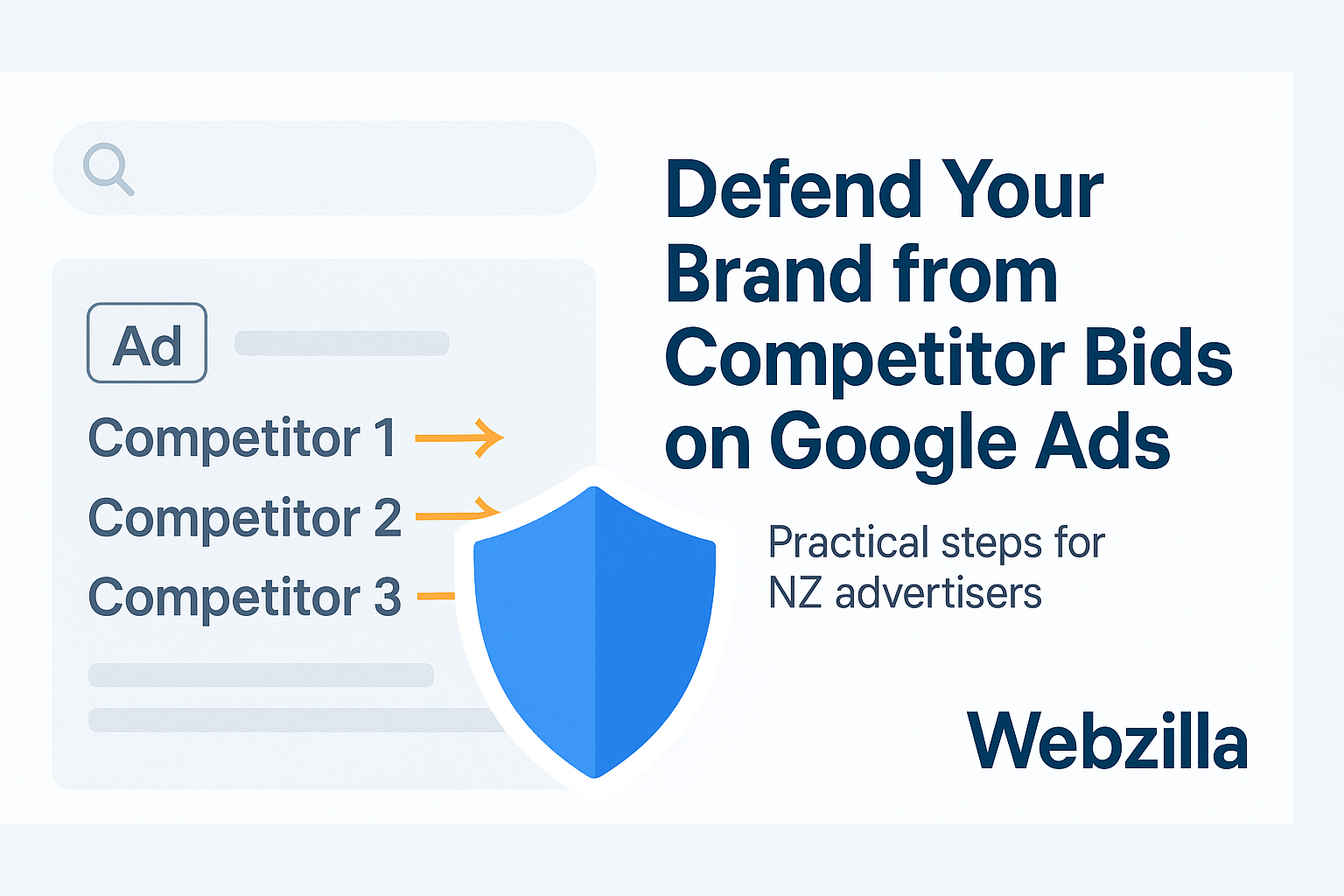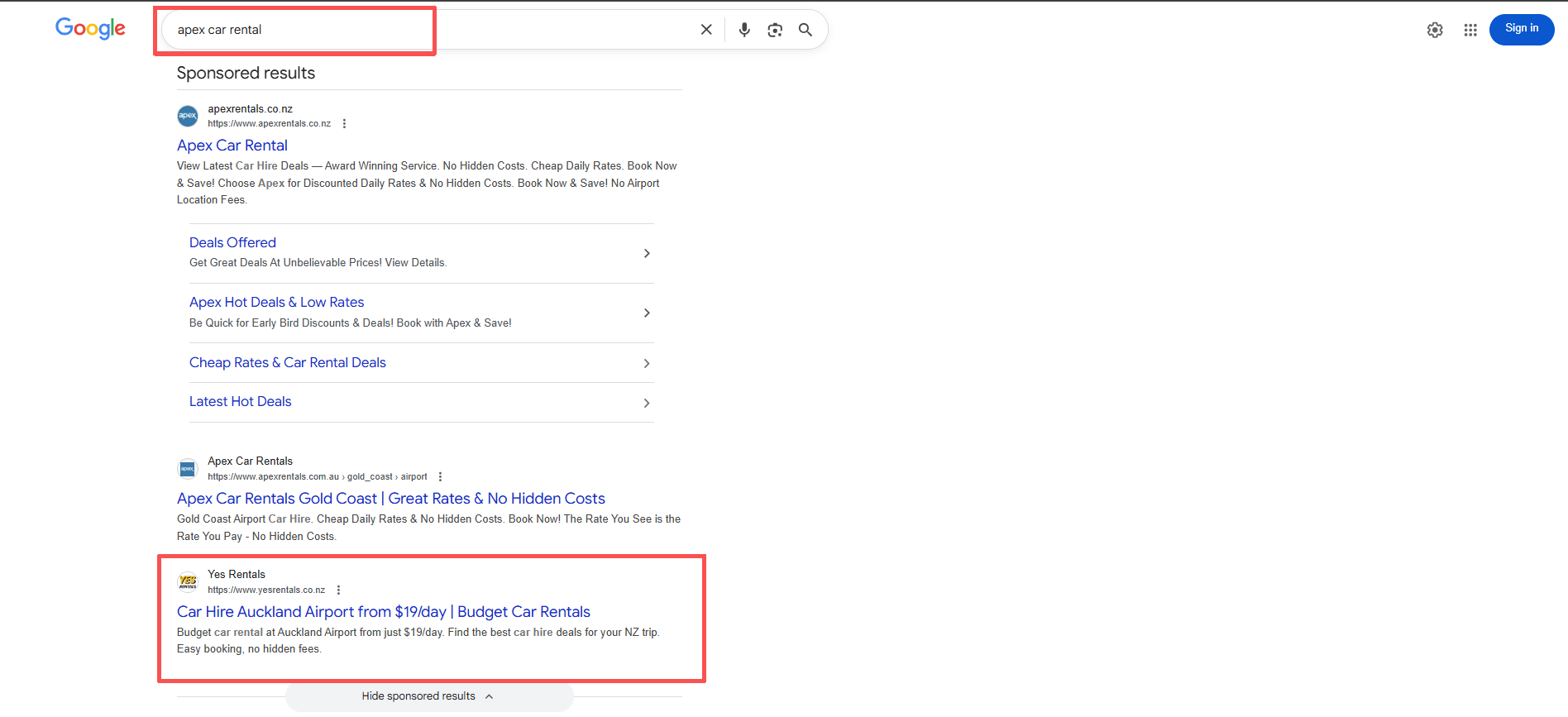
how to protect your business when competitors bid on your brand in google ads
how to protect your business when competitors bid on your brand in google ads
You log in, check your brand campaign, and notice a cluster of unfamiliar domain names sitting above you for your own name. That sting never really fades. Competitors bidding on your brand terms can siphon demand you created and nudge loyal customers off course. The good news: you can protect your position without inflating costs or starting an arms race.
This guide sets out practical steps for New Zealand advertisers, covering policy boundaries, smart account setup, legal angles, and the monitoring habits that keep you in front.
What competitor bidding actually is, and what Google allows
Buying a rival’s name as a keyword is largely permitted in Google Ads. In most markets, including New Zealand, Google allows advertisers to bid on trademarked terms as keywords. The line is drawn at ad text. Using a trademark in ad copy is restricted when the owner has submitted a valid complaint. There are carve outs, for example resellers and informational sites that meet specific criteria.
So your first move is to separate the emotional response from the rules. Competitors can bid on your name, yet they likely cannot use it in their headlines or descriptions once your trademark is on file with Google. That single distinction shapes your options.
Keep in mind that policy enforcement is not automatic. You must file, refresh, and monitor.

Decide when to fight and when to outplay
Not every competitor bid deserves a siren. Sometimes your brand sits top with a 95 percent absolute top impression share and a 3 percent CPC bump. Sometimes your ads are slipping to position two and your cost per lead has doubled.
Look at three angles: the cost impact, the sales impact, and the strategic risk. If new entrants are barely visible or only appear at odd hours, a light touch will do. If a rival is persistently stealing top slot and your branded conversion rate is sliding, move quickly.
A quick way to quantify the threat is to compare pre and post periods on brand terms. Pull CPC, CTR, conversion rate, and absolute top impression share. Add Auction Insights to see who arrived and when. A small increase in CPC with stable conversion rate might be acceptable. A big drop in CTR or absolute top impression share tells you customers are hesitating or being diverted.
Fast wins you can deploy today
Time matters here. The first week of encroachment shapes behaviour. If users learn that your competitor appears on your name, some will get curious. You want to reset that expectation quickly.
- Target impression share bidding
- Stronger extensions
- Audience layering on brand
- Match type discipline
These are tactical levers, but they compound.
Build a resilient brand campaign structure
Your brand campaign is not where you experiment. It is where you control.
Use a tight structure. Keep your core brand terms in their own campaign with exact match and phrase match, and add close variant negatives if Google starts matching to unexpected queries. Separate product or service modifiers into their own ad groups so that ad copy stays laser relevant. Name and protect your brand lists in Performance Max to keep PMax from cannibalising your search brand, using brand exclusions and campaign-level brand settings where available.
Bidding should be simple and assertive. For most brands in protection mode, a target impression share strategy at 95 to 100 percent for absolute top of page works well with a sensible bid cap. If your CPCs are spiking, raise ad rank instead of brute-forcing bids. Improve expected CTR with tight copy, sitelinks, and strong paths. Quality Score advantages on brand terms often let you win position at a lower cost than your rivals can sustain.
Extensions do heavy lifting. Sitelinks that route to high-intent destinations, callouts that underline guarantees, and structured snippets that show product ranges all push your ad down the page visually, making life harder for a rival sitting below.
Avoid dynamic keyword insertion on brand ad groups. You do not want a competitor name slipping into your ad text due to matching quirks or future changes.
Messaging that keeps customers with you
When customers search your name, they are primed. They want reassurance more than persuasion.
Lean into trust signals. Highlight delivery speed, local support, free returns, or certifications. If your category has common anxieties, address them right in the headline. If you offer price match or a Kiwi-owned story, say it. That makes click hesitation shorter and separates you from generic competitor ads.
Rotating two to three Responsive Search Ads per ad group, each with pinned headline frameworks, gives room to test tone while maintaining control. Keep your brand name as Headline 1, then test Headline 2 for value prop and Headline 3 for proof like review volume or warranty length. Use paths that mirror the brand query to reinforce relevance.
Monitor the battlefield like a hawk
Reacting late is costly. Build a monitoring cadence that surfaces competitor incursions within 24 hours.
Auction Insights is your anchor. Track overlap rate, position above rate, and outranking share for your brand campaign on a weekly view. Add alerts when absolute top impression share falls below a threshold, say 90 percent during business hours. A simple script can email you when a new domain appears in Auction Insights for your brand.
Third party tools can help but start in-house. Google Ads rules and scripts can flag CPC jumps, CTR dips, or a sudden rise in impression share lost to rank. Pair that with a manual SERP check from a clean browser in New Zealand, both mobile and desktop, at different times of day.
A quick reference for threats and responses
The signals tell you the story. Link the symptoms to the right action so you avoid wasting budget.
| Threat pattern | What you will notice | Primary action | Secondary action | What to watch next |
|---|---|---|---|---|
| Sporadic rival on weekends | Small CTR fluctuation, stable CPC | Increase target impression share on weekend schedule | Add ad customisers to surface weekend offers | Weekend CTR and absolute top share |
| Aggressive rival daily | CTR drops, absolute top share below 85 percent | Raise ad rank with stronger extensions and copy | Lift bid cap within ROI guardrails | Auction Insights outranking share |
| Rival using your name in ad text | Your brand appears in their headline or description | File trademark complaint with Google | Capture evidence and contact rival’s agency | Ad copy changes and policy notifications |
| Shopping cannibalisation | PMax steals brand traffic, search CTR dips | Apply brand exclusions and split brand search | Add brand term negatives to generic campaigns | PMax brand share and search query mix |
| New affiliates muddying SERPs | Multiple partner ads crowding page | Set affiliate and partner rules for brand bidding | Provide co-op guidelines and monitoring | Net blended CPC and partner overlap |
Use audiences to retain your advantage
Even for brand, audiences matter. Remarketing lists for site visitors and customer match lists let you tailor bids and messaging, especially in categories with repeat purchase. You can keep a tight lid on CPC by bidding more aggressively for high value segments while holding the line elsewhere.
Layer affinity or in-market audiences in observation mode on brand campaigns. They inform your insight without restricting reach. If a competitor is targeting your name to siphon first-time buyers, you can counter by raising your stance for new-to-file audiences while holding steady for existing customers who already prefer you.
Legal and policy tools in New Zealand
Policy is your ally. If a competitor uses your trademark in ad text, Google will often remove or restrict those ads when you file a complaint. Prepare by registering your trademark with IPONZ and keeping your documentation handy.
Start with Google’s trademark complaint process. Supply your registration details, ownership proof, and the specific ads or domains infringing. Mention permitted resellers or affiliates to avoid accidental removals. Google tends to enforce at the ad text level, not keyword level, which is still valuable since it strips rivals of your name in their creatives.
The Advertising Standards Authority Code in New Zealand requires that ads are not misleading. If a rival suggests affiliation they do not have, that can be challenged. The Fair Trading Act also prohibits misleading and deceptive conduct in trade. Keep records of infringing ads, dates, screenshots, and impression share data if you need a clear trail.
After policy action, consider direct outreach. A professional note to the competitor or their agency often resolves minor misuse quickly.
- Trademark filing with IPONZ: secure registration, keep certificate accessible
- Google complaint submission: file trademark complaint, include examples and authorised resellers
- Compliance follow up: monitor SERPs, save screenshots, request review if infringements reappear
- ASA and Fair Trading: assess if wording misleads, escalate with evidence when needed
Budget and bidding protection that avoids waste
Protect without burning cash. Create a shared budget ring-fenced for brand so PMax, Demand Gen, or generic search cannot tap it during automated shifts. If your organisation uses seasonality adjustments, exclude brand from aggressive modifiers that assume cold traffic.
Set a bid cap on target impression share strategies to avoid runaway CPC when a deep-pocketed rival enters briefly. Review device level performance for brand. In some verticals, mobile brand CPCs spike during certain hours while desktop remains stable. Adjust ad schedules and bid modifiers accordingly.
If you run SA360 or another bid platform, isolate brand with its own goals and algorithms. Mixed bidding across brand and generic terms often leads to under or over bidding on brand.
Shopping and Performance Max deserve attention
Many brand searches trigger Shopping or PMax placements. If those units pull clicks before your brand search ad, guardrails are needed.
Set up Shopping campaign priority tiers. A high-priority generic Shopping campaign should carry brand negatives, while a low-priority brand Shopping campaign captures brand queries with laser-focused product groups. Keep product titles clean and include your brand name so Google matches correctly when the user intent is branded.
In PMax, apply brand exclusions where available, and if you rely on PMax for brand, monitor its search term insights. If PMax is eating brand share, rebalance budgets and consider a dedicated brand PMax with strict asset controls versus a generic PMax that excludes your brand.
Consider your stance on conquesting
There is a tactical temptation to counter by bidding on competitors’ names. Sometimes it is justified, for example when you are the challenger and need visibility. It can escalate costs and invite mirror tactics though.
If you do run conquest campaigns, keep claims factual and verifiable. Avoid confusing users about affiliation. In New Zealand, that caution is more than etiquette, it is risk management under the ASA Code and the Fair Trading Act. Measure it by incremental leads at a target CPL rather than vanity CTR.
Strengthen your owned presence around brand searches
Search results for your name are more than ads. Own the real estate. Keep your Google Business Profile spotless, with up to date hours, services, and photos. Encourage reviews consistently so seller ratings show in ads. Add structured data to your site for organisation, products, FAQs, and sitelinks search box eligibility.
A robust brand SERP makes it harder for a competitor to win the first click. It also reassures undecided users who are comparison shopping.
Incident response playbook for brand protection
When a new competitor appears, tempo matters. Use a simple playbook so your team moves in sync.
- Diagnose quickly: check Auction Insights, absolute top share, and CTR across devices
- Stabilise your position: switch brand to target impression share 95 to 100 percent with a safe bid cap
- Harden creative: refresh RSAs, add four sitelinks, callouts, structured snippets, and relevant assets
- Policy sweep: scan rival ad text for trademark use, file complaints with examples if needed
- Review Shopping and PMax: confirm brand exclusions and Shopping priority structure are intact
- Set monitors: enable alerts and a daily script that flags new domains in Auction Insights
Measure what matters
Protecting your brand is not a vanity exercise. Tie it to metrics that reflect business health. Track brand search absolute top impression share, brand CPC, brand conversion rate, and share of conversions assisted by brand clicks. If you have a CRM integration, watch lead quality from brand versus generic to validate spend allocation.
Present a simple weekly dashboard that shows trend lines and flags. Keep a changelog for any shifts you make so you can attribute improvements to the right pull.
The mindset that wins
Competitors will test your perimeter. Treat brand defence as routine craft, not crisis. Clear rules, steady monitoring, and calm use of the tools Google provides will keep your name at the top where it belongs.
The best defence still starts with a brand people want to type. That part sits outside Google Ads, yet it strengthens every tactic above.

